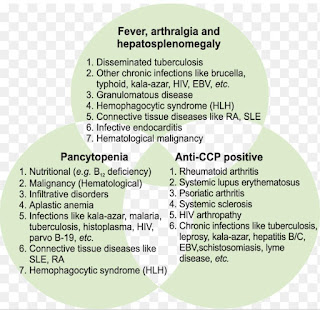Bimonthly assessment by Maddipati Sridevi
BIMONTHLY EXAM FOR THE MONTH OF FEBRUARY
Following are the links
https://archanareddy07.blogspot.com/2021/02/50m-with-parkinsonism.html?m=1
You tube link of the case:
https://youtu.be/kMrD662wRIQ
He was a 50 year old who is a diabetic since 9 months came with complaints of
Frequently walking into objects along with frequent falls since 1.5 years , drooping of eye lids since 1.5 years , involuntary movement s of hands since 1.5 years
Talking to self since 1 . 5 year, bed wetting since 1 year
He also has reduced arm swing
1 a. What is the problem representation of this patient and what is the anatomical localization for his current problem based on the clinical findings?
Ans:ANATOMICAL LOCALIZATION TO HIS PROBLEMS
The anatomical location is in Brain (in the Basal ganglia and substantia nigra ) addressing his problem of frequent falls
Nocturnal enuresis suggest that the frontal lobes in general, and the superior frontal gyri in particular, as they are important in volitional bladder control.
Etiology:
The other differential include Myasthenia gravis as the patient complained of ptosis which progressed by the night. We performed an Ice Pack test to rule out Myasthenia Gravis. After an Ice pack test, in Myasthenia Gravis, the eyelid droop improves by atleast 2-3 mm, which wasn't seen in this patient & also the drooping of his eyelids were intermittent
Series of events:
Seizures 10 years back
Type 2DM 2 years back
Sudden blurring of vision while riding bike met with RTA -- fracture in left leg ,operated 2 years back
Frequently walking into objects along with frequent falls,drooping of eyelids,Involuntary movements of hands,Talking to self 1.5 years backS
Stopped alcohol & tobacco consumption 1 year back
Non productive cough 8 months backo
Non healing ulcer at surgical site 7 months back
For 1 week - diagnosed as PSP & discharged with SYNDOPA 110 MG & QUETIAPINE
5 days later patient presented to casualty in a state of unresponsiveness with GCS: 3/15 with H/o 2-3 episodes vomiting.
Another 2 episodes of generalized tonic seizures in casualty - treated with levipil
Suddenly his saturations & heart rate dropped with no peripheral pulsations and patient was intubated - CPR done and was resuscitated.
Currently on mechanical ventilator on cpap
C)What is the efficacy of each of the drugs listed in his current treatment plan
Quetiapine:
It is used to treat psychosis in PSP
SYNDOPA: helps parkinson as well as psp according to ncbi
Case:2
Patient was apparently asymptomatic 2 years back then he developed weakness in the right upper and lower limb, loss of speech.
Links below
https://ashfaqtaj098.blogspot.com/2021/02/60-year-old-male-patient-with-hrref.html?m=1
htpps://youtu.be/7rnTdy9ktQw
a). What is the problem representation of this patient and what is the anatomical localization for his current problem based on the clinical findings?
Problem presentation:
60 year old male non diabetic & non hypertensive who had a history of CVA 2 years back
Now presented with c/o SOB,pedal edema,decreased urine output & generalized weakness since 2 months.
Anatomical localization:
Heart - HFrEF secondary to CAD with EF 36 PERCENT
His examination findings were Visible apical impulse, Pericardial bulge, visible pulsations, dilated veinsshift of apex beat to 6th ICS, Thrill at the apex, Loud S1 present, loud P2 present, S3 Accentuating on inspiration- RVS3, Expiration - LVS3
His Ecg shows poor R wave progression
Chest Xray PA shows Cardiomegaly
His 2Echo is suggestive of Heart failure DCMP with Hypokinesia at RCA, LCX
Anatomical diagnosis:
The location to his problems is at the Heart, secondary to atherosclerosis of the vessels
Risk factors:
Alcohol
Age of 60 years
Male gender
B)Etiology to his current problems :
CAD leading to DCMP
Diagnosis:DcmP with an EF of 34% secondary to CAD
CVA 6 months back (? Left ischaemic stroke)
Case:3
52 year old male , shopkeeper by profession complains of SOB, cough ,decrease sleep and appetite since 10 days and developed severe hyponatremia soon after admission.
Morehere:
https://soumya9814.blogspot.com/2021/01/this-is-online-e-log-book-to-discuss.html?m=1
Case presentation video:
https://youtu.be/40OoVEQBgS4
a) What is the problem representation of this patient and what is the anatomical localization for his current problem based on the clinical findings?
Problem representation:
A 52 year old who is diagnosed hypertensive and diabetic came with complaints of dyspnea since 10 days , cough since 2 days, dcreased sleep&appetite , complaints of anemic symptoms
Anatomical localization:
Anemia - Nutritional(iron and B12 deficiency)
Hyponatremia -SIADH or dilutional
b) What is the etiology of the current problem and how would you as a member of the treating team arrive at a diagnosis? Please chart out the sequence of events timeline between the manifestations of each of his problems and current outcomes.
Etiology:
Dimorphic anemia may be secondary to ? Nutritional
Hyponatremia secondary to free fluid (dilutional) or poor sugar control (hyperglycemia)
Sequence of events:
Type 2 DM & HTN since 1 year
And
SOB,Cough
Decreased sleep and appetite (10 days)Admitted
Diagnosed with Dyselectrolytemia (hyponatremia)
Treated conservatively & discharged
c) What is the efficacy of each of the drugs listed in his current treatment plan especially for his hyponatremia? What is the efficacy of Vaptans over placebo? Can one give both 3% sodium as well as vaptan to the same patient?
Can be given if it is SIADH tolvaptan can be given.
3percent NS may not be necessary because sodium levels here are 131 near to normal lower limit,no need of correction acutely.
4) Please mention your individual learning experience from this month
Being posted in general medicine, being an intern here is different and new experience compared to other postings and I am loving it
Learnt how to make e logs
Few of the blogs I have made:

Comments
Post a Comment